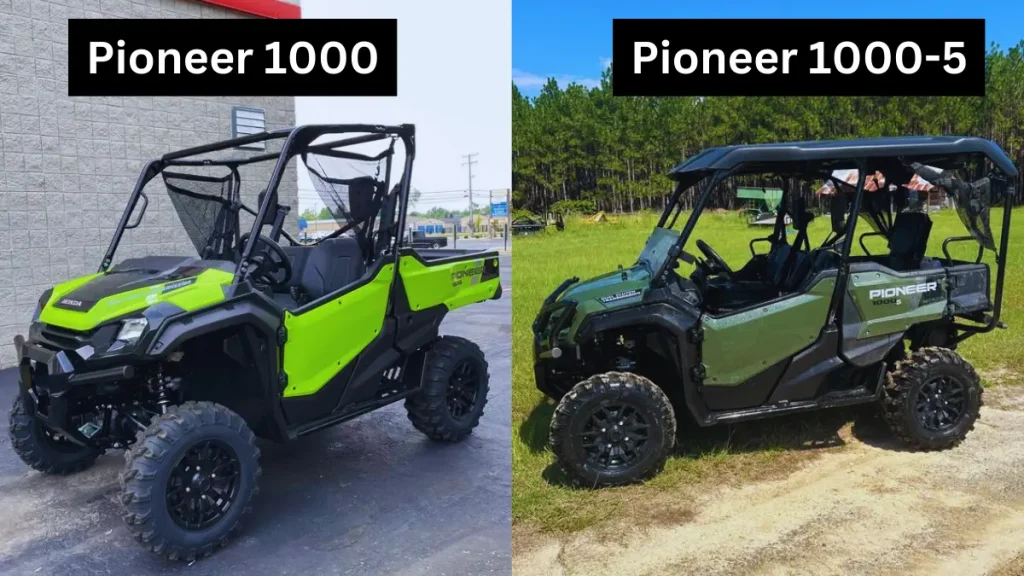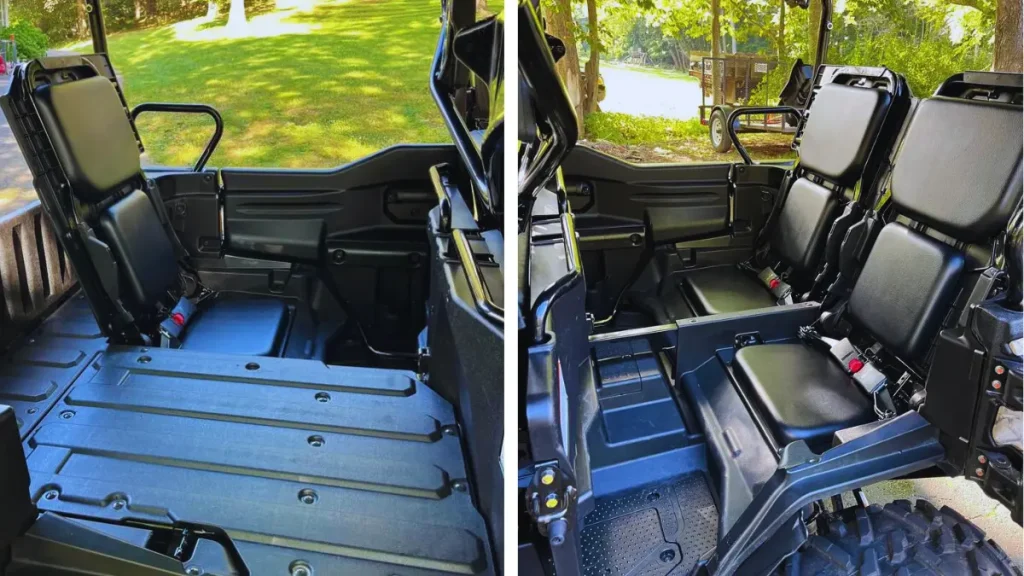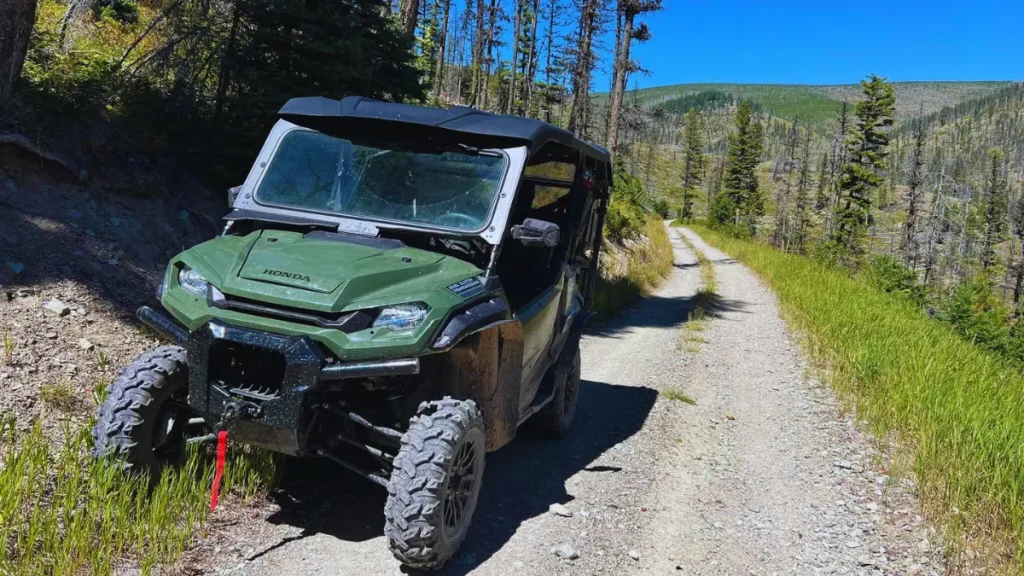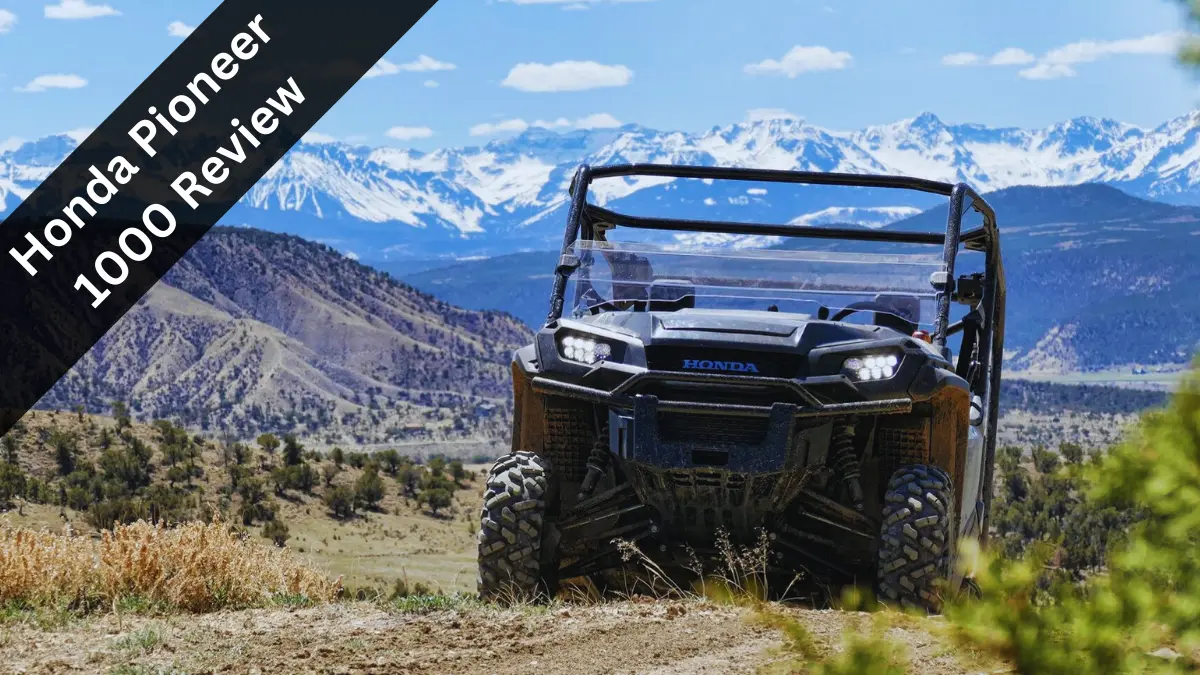When the Honda Pioneer 1000 models came along in 2016, they revolutionized the true utility UTV industry.
These models have seen extensive upgrades since then, still making for some of the best all-around UTVs you can find.
And reviews support this, with most of them raving about the overall high quality and excellent performance of these models.
Despite that, the number of drawbacks identified with these vehicles might surprise you.
While not deal-breakers, this detailed review of the Honda Pioneer 1000 models will highlight every last drawback along with each of their strengths as well.
In it, we’ll detail:
- The three different Honda Pioneer models and their prices
- Specifications
- Key features
- Performance
- Top speed
- Overall pros and cons of these models
You can see how the Pioneer 1000 stacks up with the rest of the line in this full review of the Pioneer 700 models, detailed look at the Pioneer 520, and Pioneer 500 review.
Honda Models, Trim Levels & Their Prices
There are three different Honda Pioneer models, each with varying trim levels that include various different add-on features.
Honda Pioneer 1000
The Pioneer 1000 is Honda’s 3-seater and features four different trim levels:
| Trim Level | 2023 Price |
| Pioneer 1000 (Base) | $17,499 |
| Pioneer 1000 Deluxe | $18,899 |
| Pioneer 1000 Trail | $20,899 |
| Pioneer 1000 Forest | $20,899 |

Honda Pioneer 1000-5
The 1000-5 models feature a full length top roll-cage and roll-bar that extends over and around the back of the rear cargo bed., with the rear cargo bed folding up into two rear seats.
The rear cargo bed in these models can be folded up and converted into two additional rear seats.
They comfortably seat five riders hence the “-5” in their name.
| Trim Level | 2023 Price |
| Pioneer 1000-5 (Base) | $18,899 |
| Pioneer 1000-5 Deluxe | $20,299 |
| Pioneer 1000-5 Trail | $22,299 |
| Pioneer 1000-5 Forest | $22,299 |

Pioneer 1000-6 Deluxe Crew
The Pioneer 1000-6 Deluxe Crew only comes in one trim level and offers a fully extended rear cab and second row of seating to comfortably fit five riders, plus a cargo bed in the rear.
| Trim Level | 2023 Price |
| Pioneer 1000-6 Deluxe | $21,899 |

Specs, Key Features & Performance
Engine
The Honda Pioneer 1000 is powered by a 999cc twin-cylinder Honda engine with a maximum power output of 72 horsepower.
The throttle response is excellent thanks to some serious low-end torque, enabling you to really launch off the line when starting from a stopped or slowed position.
The Honda engine is incredibly quiet and lacks any engine vibration, even at top speeds. You won’t need earplugs, won’t scare off the animals, and can easily hear your passenger speak.
It goes without saying that as we’ve come to expect from Honda, their engines are about as bullet-proof as they come.
| Engine Type | Four-Stroke SOHC |
| Cylinder Arrangement | Twin Cylinder |
| Displacement | 999 CC |
| Max Horsepower | 72 HP |
| Bore x Stroke Ratio | 92 x 75.2 mm |
| Compression Ratio | 10.0:1 |
| Fuel System | EFI |
| Engine Cooling | Liquid Cooling |
| Fuel Capacity | 7.9 Gallons |
Drivetrain
The Pioneer 1000 offers selectable 2WD/i4WD. Honda’s i4WD will electronically apply more power to the wheels that need it for increased traction in this drive mode.
This model also features Turf mode to keep you from spinning tires, along with a true front and rear locking differential for added traction.
The 6-speed dual-clutch transmission with Reverse is unique and closer to the transmission you’ll find in many cars than what you’ll find in most other UTVs.
This transmission doesn’t make use of a drive belt, so you don’t have to worry about issues caused by worn or blown belts at any point.
This dual-clutch transmission also makes for lightning fast shifting, with the Pioneer 1000 automatically shifting through the gears without hesitation as you give it more gas.
There are also three shift modes you can choose from – Standard, Sport, and Manual with paddle shifters on the steering wheel for those who prefer to shift manually.
| Chassis Frame | Steel Tube |
| Drive System | 2WD/4WD w/ locking front/rear differentials |
| Transmission Type | 6-Speed Dual Clutch Automatic |
| Gearshift | P-R-N-H-L |
Tires & Brakes
The Honda Pioneer 1000 models each come equipped with 27-inch knobby tires in the front and rear, offering plenty of traction in all terrains and elements.
There are dual hydraulic disc brakes located on each wheel, which offer plenty of stopping power for these heavier machines.
| Front Tires | 27 x 9-14 |
| Rear Tires | 27 x 11-14 |
| Wheels | Stamped steel |
| Front Brake Type | Hydraulic Disc (210 mm) |
| Rear Brake Type | Hydraulic Disc (210 mm) |
Suspension
The suspension system on these models is one of their best features, with independent front and rear double wishbone set-ups offering 10+ inches of travel and making for an ultra smooth ride.
They also offer one of the best ground clearances in the industry among the strictly utility-based side-by-sides, at just over 13 inches.
Another big plus is the CV boots on the power steering, axles, and wheels are extremely tough and robust. These are generally fail points on some machines, but not on the Honda Pioneer 1000 models.
The 1000 base and deluxe models are equipped with unnamed utility shocks, while the Trail and Forest models get an upgrade to Fox QS3 shocks with three different settings to choose from.
The turning radius is one of the drawbacks of these longer machines, especially on the Pioneer 1000-6 Deluxe, as you’ll find yourself needing to make multiple-point turns on tighter trails.
| Turning Radius | 13.8 feet |
| Wheelbase | 80.2 inches |
| Max Ground Clearance | 13.6 in (3-Seat), 13.2 in (5-Seat) |
| Front Suspension | Independent Double Wishbone |
| Rear Suspension | Independent Double Wishbone |
| Front Travel | 10.6 in |
| Rear Travel | 10 in |
Dimensions & Capacities
The Pioneer 1000 is one of the longer utility vehicles you’ll find in the industry. While this makes for excellent cab space, it doesn’t make for an excellent turning radius.
These vehicles are also pretty heavy, but the standard electronic power steering they come equipped with makes handling and controlling them a breeze despite all that weight.
The Honda Pioneer 1000 models are right up there with the best towing capacity in the industry, only outdone by the new 2024 Polaris Ranger 1500 models.
Each also offers a sizable cargo bed with a hauling capacity of up to 1,000 lbs.
| 3-Seaters | 5-Seaters | |
| Length | 117 – 120 in | 117 – 119 in |
| Width | 63 in | 63 in |
| Height | 77 in | 77 in |
| Wet Weight | 1,595 – 1,676 lbs | 1,720 – 1,793 lbs |
| Towing Capacity | 2,500 lbs | 2,500 lbs |
| Cargo Bed Capacity | 1,000 lbs | 1,000 lbs |
Honda Pioneer 1000 Top Speed
The Honda Pioneer 1000 models are powered by a 9999cc twin-cylinder engine with a max output of around 72 horsepower.
While they’re loaded with plenty of power and low-end torque, these true utility models are geared lower with working tasks, towing, and hauling in mind more than top-end speed.
That said, the Honda Pioneer 1000 top speed is around 65-67 mph.
A speed limiter kicks in in this range, limiting the top-end speed. But you can bypass the speed limiter in the Pioneer 1000 to make it faster.
When riding with one or more passengers, you’re probably looking at a more realistic top-end speed of 60-63 mph.

Honda Pioneer 1000 Pros & Cons
Pros
- Extremely well-made, nothing feels or looks cheap.
- No squeaking or rattling like so many other UTVs suffer from.
- Easy access to the engine and maintenance just under the rear dump bed.
- The cab space is excellent with plenty of legroom up front and in the second row for the crew models.
- Power steering makes for incredibly easy steering when working around property.
- Seats are extremely comfortable, with your rear end having plenty of padding even when trail riding.
- Double latching rear tailgate offers plenty of strength to sit or stand on when loading or unloading.
- The non-crew models comfortably seat 3 grown adults up front and offer three seatbelts.
- Offer the best towing capacity in the industry.
- The CV boots are tough and will withstand hard riding unlike those of some other models.
Cons
- Turning radius is not great, leading to a number of multiple-point turns while out trail riding.
- The dump bed handle is located in the rear of the cab area, making it easy for riders to accidentally pull on it while driving and dump your gear or cargo.
- The only sealed dry storage space is in the small glove box, with no dry storage space under the seats.
- The plastic roof has a channel design in it that accidentally accumulates water when it rains, which then flows down into your lap off the roof when you start driving.
- The dual-clutch transmission can be a little jerky if not enough oil.
- Power steering can feel a little over-boosted when trail riding.
- The driver’s dead pedal footrest is up a little high making for an awkward position when using it.
- If trail riding, riders tend to get thrown around in the cab a bit and there’s not much to grab onto as a passenger to support yourself.
- The position of the key is low enough that those with long legs can accidentally bump it and turn it with your knee when riding.
- There is a seat-belt speed limiter that will not allow the vehicle to go past 15 mph or so unless buckled, which is pretty annoying in certain situations.
For more detail on these models’ drawbacks and how to overcome them, check out this guide to the Honda Pioneer 1000’s most common issues.
Final Word
The Honda Pioneer 1000 models are some of the best all around true utility vehicles you’ll find.
That said, like any model, they don’t come without their drawbacks – most of which are minor and somewhat nit-picky.
To see how they stack up with some of their biggest competitors, check out the following before you go:


